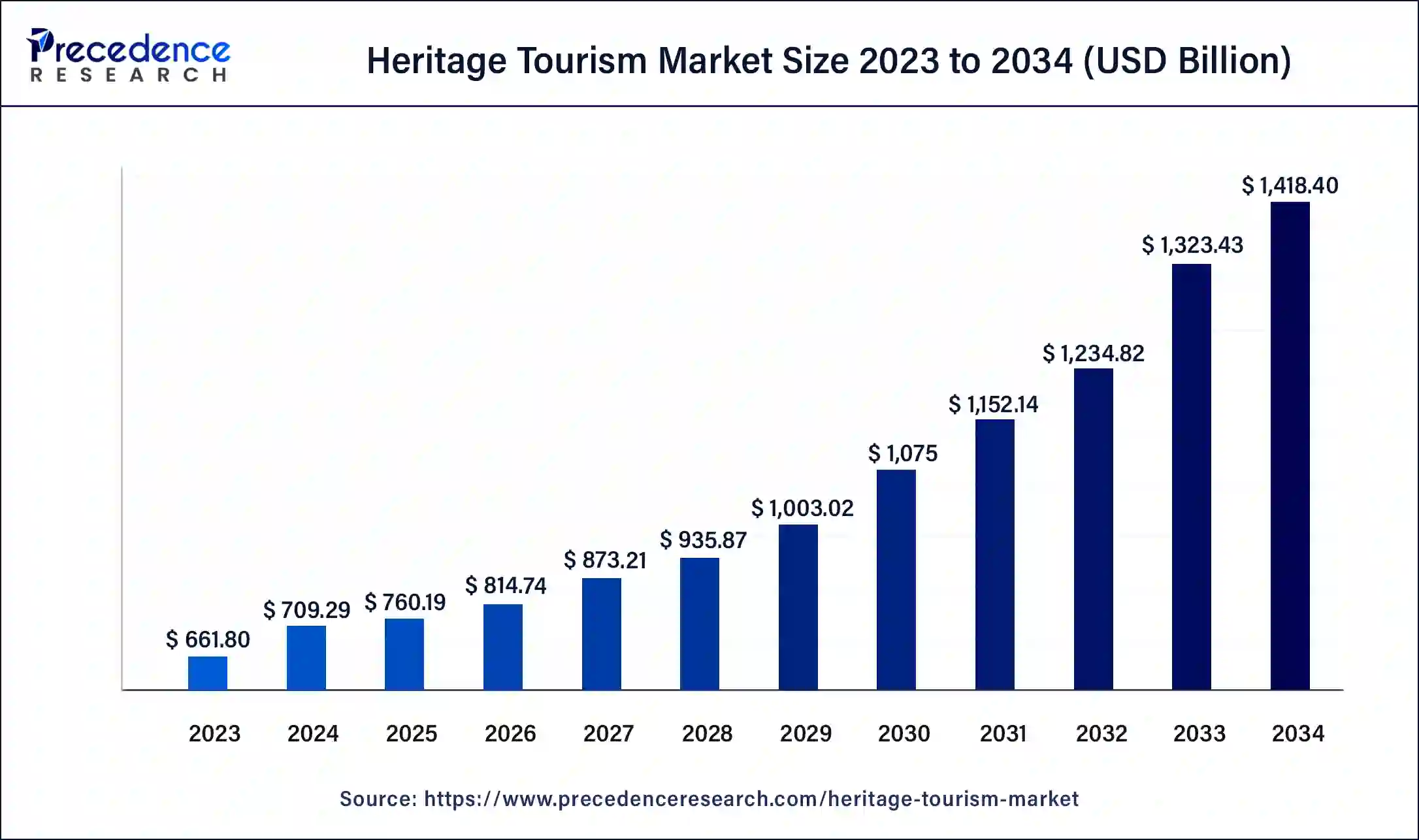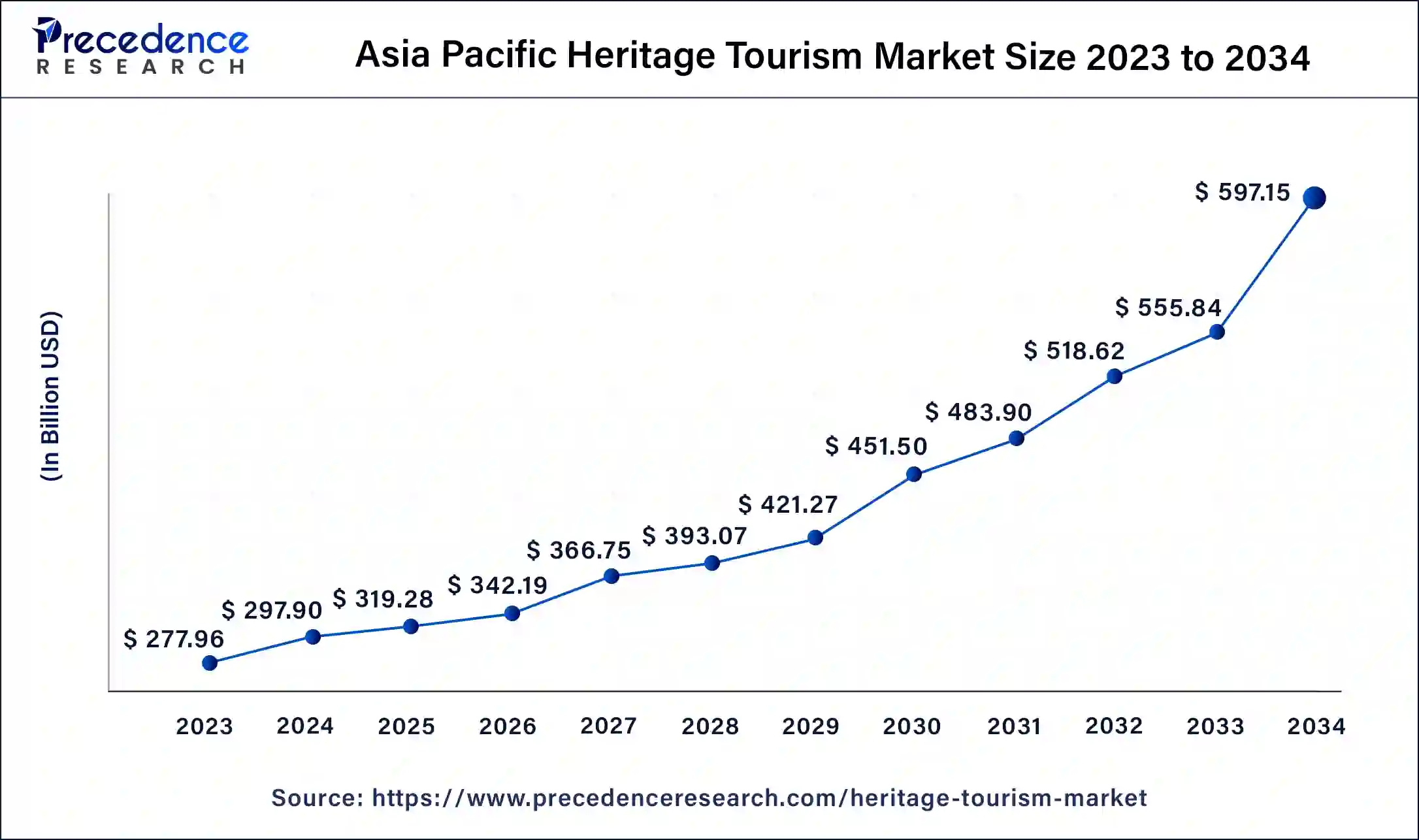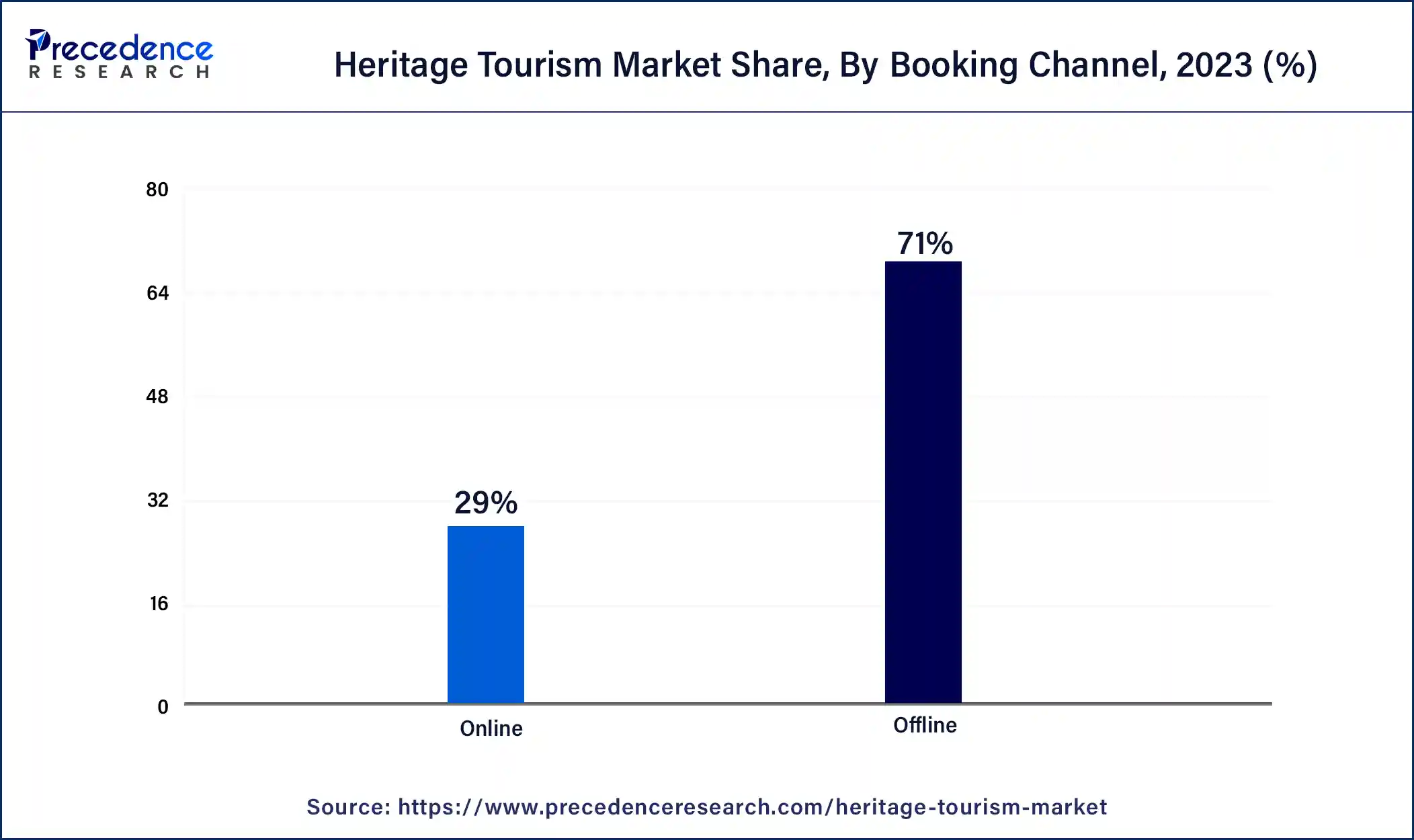March 2025
Heritage Tourism Market (By Type: Cultural Heritage, Natural Heritage, Intangible Heritage; By Booking Channel: Online, Offline; By End-user: 30 & under, 31 to 50, 51 to 70, 71 & above) - Global Industry Analysis, Size, Share, Growth, Trends, Regional Outlook, and Forecast 2024-2034
The global heritage tourism market size was USD 661.80 billion in 2023, calculated at USD 709.29 billion in 2024 and is expected to reach around USD 1,418.40 billion by 2034, expanding at a CAGR of 7.17% from 2024 to 2034. The growth of the heritage tourism market is substantially driven by the initiatives taken by the governments to promote culture in the tourism industry.

The Asia Pacific heritage tourism market size was exhibited at USD 277.96 billion in 2023 and is projected to be worth around USD 597.15 billion by 2034, poised to grow at a CAGR of 7.19% from 2024 to 2034.

Asia Pacific dominated the heritage tourism market in 2023. This growth is due to the rich cultural heritage found in the region, largely contributed by China, India, and Japan. Many destinations across the Asia Pacific provide various cultural experiences, ranging from ancient civilizations to the colonial histories of different countries. The promotion of heritage tourism, coupled with advanced travel infrastructure and online booking platforms, supports market expansion. Moreover, the increasing popularity of cultural exploration attracts travelers seeking authentic and immersive experiences that link them to historical roots.
Middle East & Africa is expected to experience the fastest growth in the heritage tourism market over the studied period. This region's growth is expected to be driven by increasing government efforts to promote tourism and culture. Middle East & Africa (MEA), known as the birthplace of Western and Arab civilizations, is home to numerous significant world religions. Hence, the area is rich in heritage sites that attract tourists and serve as symbols of national, cultural, and religious identity. However, heritage in the region is highly contested and has even become a target for terrorism, which can pose significant challenges to heritage management and sustainable tourism development.

Heritage tourism involves travel aimed at immersing oneself in a destination's cultural, historical, and natural legacy. This sector attracts history buffs, cultural lovers, and nature enthusiasts. The surge in heritage tourism has significantly bolstered the GDP of numerous developing nations. Over time, the expansion of heritage tourism has influenced revenue generation in various countries worldwide, with visitor expenditures at heritage sites rising substantially. Nations rich in culture and heritage are implementing special promotional strategies to highlight their heritage sites and attract tourists. Heritage tourism offers a unique blend of education, economic benefits, and entertainment.
Seasonality in Foreign Tourist Arrivals in India
| Month | 2022 | Growth % 2021/20 | Growth % 2022/21 | Share % |
| January | 215,935 | -91.5 | 128.11 | 3.35 |
| February | 254,538 | -89.2 | 130.74 | 3.95 |
| March | 358,023 | -59.3 | 167.64 | 5.56 |
| April | 411,010 | 2691.4 | 422.13 | 6.38 |
| May | 445,690 | 425.1 | 2154.95 | 6.92 |
| June | 547,074 | 319.9 | 1416.70 | 8.50 |
| July | 669,499 | 472.9 | 823.43 | 10.40 |
| August | 524,756 | 369.2 | 465.91 | 8.15 |
| September | 551,580 | 310.6 | 376.89 | 8.57 |
| October | 677,055 | 361.3 | 253.71 | 10.52 |
| November | 789,330 | 271.8 | 199.14 | 12.26 |
| December | 992,977 | 250.8 | 212.60 | 15.42 |
| Report Coverage | Details |
| Market Size by 2034 | USD 1,418.40 Billion |
| Market Size in 2023 | USD 661.80 Billion |
| Market Size in 2024 | USD 709.29 Billion |
| Market Growth Rate from 2024 to 2034 | CAGR of 7.17% |
| Largest Market | Asia Pacific |
| Base Year | 2023 |
| Forecast Period | 2024 to 2034 |
| Segments Covered | Type, Booking Channel, End-user, and Regions |
| Regions Covered | North America, Europe, Asia-Pacific, Latin America, and Middle East & Africa |
The popularity of cultural and natural heritage
Heritage, culture, and nature have become integral to social and economic development strategies. Countries are leveraging their rich historical backgrounds to gain a competitive edge, as the tourism industry is more intertwined with a nation's culture and heritage than any other sector. Moreover, Heritage directly contributes to the economy and society by generating income and creating job opportunities, enhancing social well-being, and fostering the development of social capital. The connection between culture and the economy has evolved from merely preserving heritage sites to actively promoting economic growth, which can drive the heritage tourism market expansion.
Funding concerns
Preservation laws and regulations can restrict modifications and developments at heritage sites, limiting the ability to enhance facilities and services for tourists. This can hinder the growth of the heritage tourism market. Heritage sites often require significant funding for maintenance and preservation, which can be scarce. Inadequate funding can lead to deterioration of sites, reducing their attractiveness to tourists. There can be resistance from local communities who may be concerned about the impact of tourism on their cultural and social environment.
The increasing popularity of historical TV shows and movies
Historical TV shows and movies' growing popularity drives the heritage tourism market forward. The influence of historical TV shows and films on travel decisions and the demand for authentic and immersive experiences continue to boost the market by benefiting local economies and supporting cultural preservation initiatives. As audiences become captivated by the storytelling and visual portrayal of historical events, they desire to visit the featured sites, which can lead to increased heritage tourism. Furthermore, these entertainment mediums provide an engaging look into the past, arousing curiosity and interest in historical eras and iconic locations showcased in the narratives.
An article published in Business Standard on October 2023 says that almost 94% of Indians are inspired by movies or TV shows for travel destinations that they've seen on the big or small screen, be it Paris, inspired by the hit sitcom ‘Emily in Paris, or Manali, shown in superhit film ‘Yeh Jawaani Hai Deewani.
The cultural segment dominated the global heritage tourism market in 2023. This growth is due to the abundance of cultural sites and the strong preference among travelers for visiting historical and cultural locations. Cultural sites, encompassing monuments, buildings, and artifacts, possess a tangible presence. Also, these sites are regarded as valuable for preservation and are highly popular among cultural tourists. This trend is anticipated to contribute positively to the expansion of the cultural tourism market.
The natural segment is expected to grow at a faster pace in the heritage tourism market over the forecast period. Natural heritage, including national parks, wildlife sanctuaries, and picturesque landscapes, attracts travelers eager to experience nature's beauty and tranquility. The appeal of untouched environments and eco-tourism opportunities draws nature lovers and adventure enthusiasts to these locations. Sustainable tourism visits to UNESCO natural heritage sites are on the rise, and this aims to minimize the impact of human activity on these areas.
The offline segment led the heritage tourism market in 2023. This demographic tends to book trips through travel agents and other offline channels because of the convenience and simplicity of the services offered. This is due to the greater consumer preference and perception of offline channels. Additionally, these channels' longstanding nature and widespread availability worldwide are anticipated to influence the global market significantly. Thus, baby boomers and the older generation are significant travelers in the global market.

The online segment is expected to show the fastest growth in the heritage tourism market through the projected period. Planning a trip typically requires substantial time and effort for research and making optimal decisions. However, the advent of online travel agencies has undoubtedly accelerated the process while providing clients with a broader range of options. Those who book online tend to compare travel options on booking portals and hotel websites. It can propel the segment growth further.
The 51 to 70 segment held the largest share of the heritage tourism market in 2023. This can be linked to the shift in consumer preferences and the growing interest in cultural travel and tourism are significant factors behind it. Elderly people are more inclined to visit cultural sites and spend money on such experiences compared to younger age groups, who generally prefer leisure and adventure activities. This older traveler demographic tends to be affluent, well-educated, and likely to travel for extended periods. Additionally, this group is expected to see strong growth soon, driven by an increasing inclination toward cultural travel and a willingness to invest in travel and tourism.
The 31 to 50 segment is anticipated to witness the fastest growth in the heritage tourism market during the forecast period. With greater disposable income and a quest for personal growth and enrichment, this age demographic is eager to explore historical and cultural destinations. They value the educational significance and nostalgic charm of heritage sites, which makes heritage tourism a compelling choice. Furthermore, their desire for diverse and unique experiences drives the demand for specialized heritage tours and packages that foster market growth as travel companies specify their offerings to meet these interests and preferences.

Segments Covered in the Report
By Type
By Booking Channel
By End-user
By Geography
For inquiries regarding discounts, bulk purchases, or customization requests, please contact us at sales@precedenceresearch.com
No cookie-cutter, only authentic analysis – take the 1st step to become a Precedence Research client
March 2025